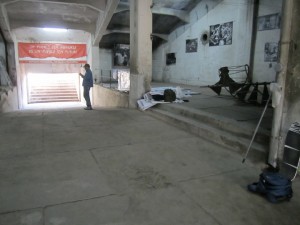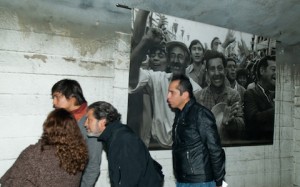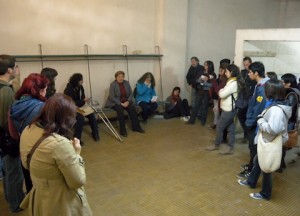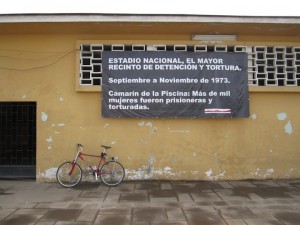National Stadium, national memory: A personal letter
06 June 2012 – Zachary McKiernan
Letters from Chile, social justice, public engagement, memory, museums, government, human rights, international, politics

Incomplete and semi-permanent interventions in Escotilla 8, a “special protection” site within the Chilean National Stadium
This is a personal letter. It is personal because I came to Chile to write and participate in the history of the museum project “National Stadium, National Memory,” whose aim is “the material establishment of national memory in respect… to the Concentration Camp… in 1973.” Where I ended up some seven months later in the network and politics of human rights and public memorials is a story that will unfold in the dissertation, tentatively titled Public History and Human Rights: The National Stadium of Chile and the Power of Public Memorials. But that’s for next year. This year, though, has been a real life lesson in preparation for a career in public history. That this lesson is intimately linked to human rights through historically oriented projects makes it equally empowering and problematic—and a reminder of a question my venerable advisor Randy Bergstrom constantly asks me: what and where is the line between personal activism and professional responsibility? Navigating this and other ethical challenges has been at the center of my study and approach to an engaged scholarship of advocacy.
Ever since the National Stadium of Chile was converted into the country’s largest concentration camp on the same day the military violently overthrew Salvador Allende’s democratically elected government, it has been a sacred, albeit scarred, spot in the memoryscape of Chileans. National Stadium, National Memory is the latest—and largest—attempt to memorialize the stadium as it was for 58 days in 1973: the physical and figurative starting point for seventeen years of massive human rights violations. From the prisoners themselves through the famous human rights velatones (commemorative candle ceremonies) to a 2003 National Historic Monument designation, the stadium, “a ‘national icon’ that… undoubtedly forms part of [Chileans’] collective identity” (Ministry of Education, 2004), has proved a constant stage for “irruptions of memory”—or “public events that break in upon Chile’s national consciousness… to evoke associations with symbols, figures, causes, ways of life which to an unusual degree are associated with the political past that is still present in the lived experience of a major part of the population” (Alexander Wilde, “Irruptions of Memory: Expressive Politics in Chile’s Transition to Democracy,” Journal of Latin American Studies, Vol. 31, May, 1999, page 475).
What sets the stadium apart from other recovered sites of memory in Chile is that it is connected by its very nature through sporting events, concerts, and a multitude of other cultural and political occasions to a major part of the population. Too, with its prisoner count reaching to what some have estimated to be 20,000, the stadium experience crossed all sectors of Chilean society, a microcosm comprised of housewives and workers and Allende’s government officials and military men. Thus, the importance of National Stadium, National Memory cannot be understated. What is important to know, though, is that this project—given the personalities involved, the raw power of the stadium itself, and a complicated and constantly changing political present—has developed in a piecemeal manner. It was finally approved in 2010 under President Michelle Bachelet’s outgoing government. Before that it was entrenched in a fierce battle with the formerly approved, never executed, and now discontinued stadium project “Open Museum, Site of Memory and Heritage.” This battle began in 2003 when the original museum committee fractured, unleashing, from what archival records and recent interviews indicate, a long war of attrition, suspicion, and division between human rights actors, professional, and politicians. Because of this and other less obvious oddities associated with the stadium (see dissertation), the new project has lacked the financial, professional, and institutional support necessary to see it to its final fruition.
Despite this, the struggling memorial under the direction of the human rights organization Metropolitan Region of ex Political Prisoners (RMEPP) is engaged in important historical work at the stadium. There, the organization is charged with the preservation of 10 sites with “special protection” status, a strategy to keep them as they were in 1973. These places are where prisoners entered the stadium, where they slept and lived, and where they were tortured and terrorized. The approved though only partially executed project plans to fill these areas with historical interventions and exhibits. Meanwhile, on Saturdays or by special appointment, interpretive tours are offered as a “memory route” to retrace these remnants. In addition, the organization, aided by an investigative team, is currently creating an audio-visual archive of ex-prisoners’ testimonies. This oral history component, which began in November, is the most concentrated effort to recover and record the voices of the stadium’s prisoners. From a critical perspective, however, I have noted serious problems in the planning, execution, and even personal motivations of these interviews—and have subsequently stepped away as a participant, chalking up another challenge for (academically trained) practitioners of history working in the field of human rights.
Apart from the pending and partially implemented intervention and exhibits, the motivation to create an audio-visual archive, and the on-going interpretive “memory route” tours, a final goal of RMEPP is to keep the stadium’s specially protected sites active with human rights performances and commemorations. One example is the production of “Once Upon Time… a King, 571 Days of a Political Prisoner” inside the “Women’s Locker Room” (a protected/preserved site where women were imprisoned) by the Colectivo Teatral La Escotilla. What is especially unique about this production is that it was written by an ex-political prisoner and parodies the personal experiences of various detention centers throughout Chile, while the performers are ex-prisoners and family members who lived those experiences. The symbolism is great: a play about detention centers, written and performed by survivors of those centers, performed at the largest of those centers almost four decades after the fact. Participant Patricia Requena, whose father was imprisoned in the stadium and later other detention centers, explained, “We are proud of what we’re doing and that it expresses a part of the historic work to recover memory is a certainty, and that is good.”
At National Stadium, National Memory, good (and less good) things are happening. But whatever perspective one may hold, the battle over memorializing the site continues. The ultimate question for me, however, is why, after two decades of democracy, two truth commissions with recommended reparations of memorializing the most emblematic sites connected to Pinochet’s terror, and Chile’s “exciting progress in reconstructing the memory of gross human rights violations” (“Memorialization and Democracy: State Policy and Civic Action” conference, Santiago 2007), the stadium still sits without a completely constructed, much less supported, memorial. Getting to the bottom of this gets me closer to questions aimed at Chile’s (in?)complete transition to democracy and the idea of memory as a human and/or civil right (the right to memory or the right to remember?). And getting closer to these questions gets us all a little closer to thinking about what role our own personal activism and professional responsibilities play in struggles for human rights.
~ Zachary McKiernan







I’ve been interested in memory, including cultural memory, for years, and I went to the Museo de la memoria et los derechos humanos when I visited my son in Santiago earlier this year. To me, it was an object lesson in the kind of thing Ariel Dorfman has been trying to convey in his writings about the Pinochet years, the thorny links between remembering, forgetting, revenge, forgiveness, feeling comfortable with the restoration of “normalcy” and a permanent feeling of exile in a land you want to call home. The history of Latin America is a record of one revolution after another. Even in this context, Chile is an especially tortured country, and it will take generations for Chilenos and Chilenas to recover.